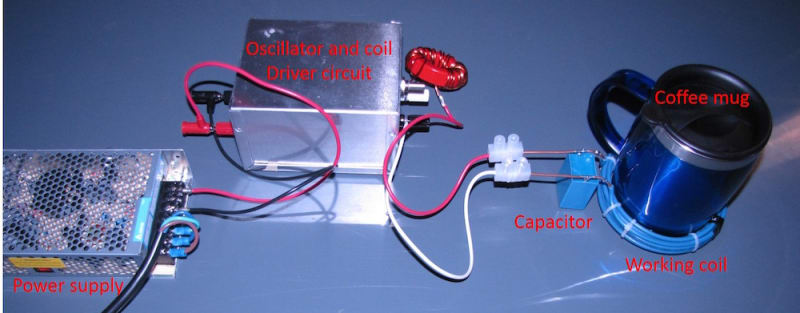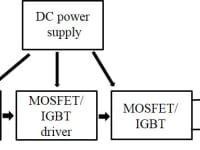Most of the coffee mug warmers available in the market utilise resistive heating. These warmers can be used with ceramic mugs or outer-body stainless steel mugs. However these are unsuitable for stainless steel-mugs with plastic outer cover used for insulation. Furthermore, these warmers are inefficient; most of the heat generated by the heating element is lost in the environment rather than warming coffee. The idea of a coffee mug warmer employing induction heating targets the stainless steel mugs with and without the outer plastic cover. The mugs with the outer plastic cover are highly efficient, as there is a less chance for heat escape. The basic principle of inductively heating a coffee mug is depicted in Fig.1. An RF generator is connected to a coil, which creates oscillating magnetic field around the coil. A stainless-steel coffee mug if placed on top of the coil or brought in close proximity to the coil, will induce eddy current in the stainless steel body causing the generation of heat. Coffee put inside the mug will be kept warm or heated according to individuals test. The temperature can be controlled by controlling the current in the coil. The working system consists of a square wave generator, a semiconductor power device (MOSFET or IGBT), a power supply and a working coil with a capacitor in parallel.The basic block diagram of the entire system is shown in figures attached.The square generator produces square wave with adjustable frequency. The square wave output drives a pair of power MOSFET or IGBT through a suitable driver to obtain high current pulses. The working coil is connected with a capacitor in parallel to form a tank circuit. The frequency of the square wave is adjusted to match the resonant frequency of the LC tank circuit. At resonance, though high current flows through the working coil, much less current flows through the power devices. The current flowing to the tank circuit is for replenishing the energy losses in tank circuit due to the resistances of the working coil and the capacitor. When the stainless steel-mug is placed on top of the coil (or partly through the coil), due to mutual induction eddy current heats the stainless steel. The amount of heat produced depends on the stainless steel properties, working coil inductance and proximity of the working coil to the mug.
The working coil is made using AWG #12 copper wire with number of turns, 7 and diameter 10 cm. A capacitor used with the coil has a value of 5 ?F. The square wave generator and the MOSFET driver were implemented using an integrated circuit. The frequency of operation was set at around 23kHz, which is the resonant frequency of the coil-capacitor tank circuit. When the circuit is connected with a 24 V DC power supply, for a typical coffee-mug temperature reaches up to 80oC. With 48 V power supply the temperature reaches quickly to the boiling point. The same circuit can be used to sterilize surgical tools by induction heating.
Like this entry?
-
About the Entrant
- Name:Sajjad Haidar
- Type of entry:individual
- Software used for this entry:LTSpice
- Patent status:none








